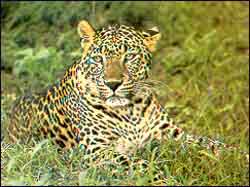| Destinations
|
|||||||||||||||
Rajasthan is a haven for a wide spectrum of wild life. Some of the most rare species of animals and birds in the numerous wild life sanctuaries and national parks of Rajasthan ironically owe their existence to the hunting pleasures of the erstwhile maharajas, who carefully nurtured forests to ensure supply of regular sport. The topography of Rajasthan ranges from the barren desert, scrub-thorn arid forests, rocks and ravines to wetlands and lush green forests. Each of these areas houses a large variety of animal and bird life, some of them rare and some endangered. Special areas have been marked as wildlife reserves. These include Desert National Park, Wood Fossil Park, Kanodiawala, Rann Gajner, Tal Chapper, Sariska, Baretha, Keoldeo Ghana, Vanvihar, Ranthambhor, Ramgarh, Chambal, Darrah, Jawahar Sagar, Sitamata, Jaisamand, Mount Abu and Kumbhalgarh. Rajasthan is the home of black bucks, chinkara, the rare desert fox, the endangered caracal, the great Indian bustard, gavial, monitor lizard, wild boars, porcupine. Amongst the 20 reserves selected under Project Tiger, launched in 1973 to save this endangered animal, the Ranthambhor National Park and Sariska Tiger Reserve are considered by both naturalists and photographers as the best places in India to view tigers. |
More on Rajasthan • An Overview • History • Geography • People & Culture • Economy • Festivals • Adventure • Climate Cities • Ajmer Shareif • Alwar • Bharatpur • Bikaner • Chittaurgarh • Jaipur • Jaisalmer • Jodhpur • Kota • Mount Abu • Ranakpur • Sariska • Udaipur
Travelogues
Impressions | ||||||||||||||
Bhensrod Garh Sanctuary
Darrah Sanctuary Previously the hunting ground of the Kota maharajas, this sanctuary was established in 1955 and covers an area of 266 sq km. This hilly sanctuary with its thick forests is worth a visit. The animals here include wolf, sloth bear, chinkara and leopard. The best time to visit is between February and May. Desert National Sanctuary Essentially an animal fair, it provides an opportunity to participate in some of the local sports.
Baneshwar Fair, Baneshwar(Jan-Feb) E stablished in 1980,it is a colossal park sprawling on 3162 sq km. It has shrubs and trees in addition to rolling sand dunes. The wild life wealth here comprises fox, desert cat, hare, spiney tail uromastix and sand fish. Thousands of sparrows, imperial sand grouse, bustards, falcons and eagles migrate here during the winter. Best time to visit is September to March. Gangaur,J aipur(March-April) A festival dedicated to Goddess Parvati, the consort of Lord Shiva. Young girls dress up in all their resplendent finery and pray for eligible grooms while married women pray for the well-being of their husbands. This 18-day festival is laced with various activities and culminates in a grand procession marking the arrival of Shiva to escort his bride home. Jaisamand Sanctuary Established in 1957, this sanctuary is located beside the man-made lake of Jaisamand. Covering a total area of 160 sq km, it harbours sloth bear, leopard, chital, chinkara, wild boar and a number of birds. Some crocodiles and fish can also be spotted here. Best time to visit is between November and January.
Keoladeo Ghana National Park, Bharatpur Declared a National Park in 1983, this 29 sq km park is one of the world's
greatest heronries. Its shallow, fresh water marsh attracts thousands of
migratory birds. Over 10,000 nests of egrets, darters, cormorants, grey
herons and storks hatch nearly 20,000 to 30,000 chicks every year. There
is a great variety of migratory birds. Mammals like the sambhar,
blackbuck, chital, nilgai, fishing cat, otter and mongoose also roam
freely here. Best time to visit is August to February.
Mount Abu Sanctuary The highest point of the Aravalli hills, the Guru Shikhar, lies in this 289 sq km sanctuary. Established in 1960,this sanctuary provides shelter to the common langur, wild boar, sambhar and leopard. The grey jungle fowl can also be spotted here. Besides, a number of flowering trees enhance the beauty of this place.
Ranthambhor National Park This is the state's best known tiger reserve under Project Tiger. Home to an expansive variety of other animals it is 392 sq km in area, and one can spot sambhar, cheetal, wild boar, leopard, sloth bear, jackal and hyena among other animals. Artificial lakes, dense forests and the shield of the Aravallis have helped to make this park a great place to visit. Best time to visit is October to April. Sariska Tiger Reserve T his is the other tigerland in Rajasthan which was brought under Project Tiger in 1979. In this reserve, other animals found are leopard, sambhar, nilgai, wild dog and chinkara. Adding a dimension of history, there are also interesting ruins of 9th and 10th century temples that exist here. Best time to visit is November to June. Other sanctuaries in the state include Sitamata, Chambal, Tal Chapper, Jamwa Ramgarh, Kaila Devi, Van Vihar, Shergarh, Todgarh-Rad and Jawahar Sagar. |
|||||||||||||||
Editor: Romola Butalia (c) India Travelogue. All rights reserved. |
|||||||||||||||

 A fairly new sanctuary, it was established in 1983 and covers a total area
of 229 sq km of scrub and dry deciduous forest. Leopards, chinkara and
sloth bear can be spotted here if lucky. The best time to visit is between
October and May.
A fairly new sanctuary, it was established in 1983 and covers a total area
of 229 sq km of scrub and dry deciduous forest. Leopards, chinkara and
sloth bear can be spotted here if lucky. The best time to visit is between
October and May.